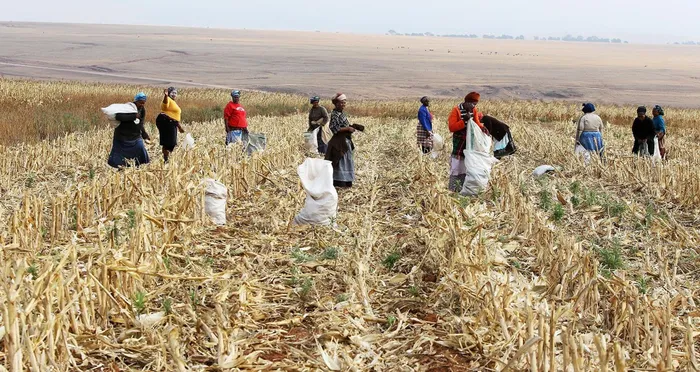South Africa poised for record summer crop harvest despite late rains
AGRICULTURE

Crop Estimates Committee area planted estimate and fourth production forecast for summer crops for 2025 released on Friday indicated that they are expecting a good harvest for the 2024/2025 season despite challenges of late rains
Image: Phando Jikelo/Independent Newspapers
As the agricultural landscape in South Africa prepares for the 2024/2025 summer season, the Crop Estimates Committee (CEC) has revealed promising estimates that signal a potentially fruitful harvest.
Released on Friday, the report highlights significant increases in expected yields for key crops such as maize, soybeans, and dry beans, despite the challenges posed by late rains across many regions.
The CEC's projected commercial maize crop stands at a robust 14.644 million tons, which is an impressive 13.96% or 1.794 million tons larger than the previous year's yield.
The majority of this production is expected to come from South Africa’s core maize-producing provinces: the Free State, Mpumalanga, and North West, which together are anticipated to contribute a staggering 81% of the total crop.
While the overall maize estimate reflects a slight decrease of 0.14% or 19 850 tons from earlier forecasts, the expected yield has stabilised at 5.64 tons per hectare.
The breakdown of the maize forecast indicates that white maize is expected to reach 7.648 million tons, a dip of 1.40% or 108 250 tons from the previous estimate, while yellow maize is projected to increase by 1.28% or 88 400 tons to a total of 6.996 million tons.
In addition to maize, the sunflower seed forecast has been adjusted to 727 800 tons, which reflects a 2.02% or 15 000 tons decline from previous estimates. The area dedicated to sunflower cultivation is expected to cover 555 700 hectares with a yield of 1.31 tons per hectare.
Conversely, there is an optimistic outlook for dry beans, with production forecasts showing a positive trend—rising by 1.24% or 875 tons for a total of 71,415 tons, supported by an area estimate of 45,620 hectares and an expected yield of 1.57 tons per hectare.
Wandile Sihlobo, chief economist at the Agricultural Business Chamber said that the 2024-25 summer grains and oilseeds harvest was in full swing across South Africa, with oilseeds nearing completion.
Despite a late start caused by prolonged rainfall that continued into April, farmers are reporting generally positive crop conditions, although some regions are experiencing quality issues
“Feedback from various farmers regarding crop conditions remains encouraging, although there are quality challenges in some regions. For maize, deliveries are still low, as the season is late by over a month compared to the usual period due to prolonged rains through to April,” Sihlobo said.
Sihlobo said that more specifically, South Africa's maize harvest is now forecast at 14.78 million tons, which is 15% higher than the crop for the 2023-24 season.
“Of these 14.78 million tons, about 7.65 million tons is white maize, and 7.13 million tons is yellow maize. Importantly, these forecasts are well above South Africa's annual maize needs of approximately 12.00 million tons, implying that South Africa will have a surplus and remain a net exporter of maize.”
Sihlobo added that regarding oilseeds, the soybean harvest was estimated at 2.65 million tons, representing a 43% year-over-year increase.
“The annual uptick is primarily due to improved yields resulting from favourable rainfall. Sunflower seeds are up 15% from the previous season and are estimated at 727 800 tons.”
Francois Rossouw, CEO of Southern African Agri Initiative (Saai), commented on the CEC’s slight downward revisions for white maize and sunflower seeds, attributing them to natural fluctuations as harvest data becomes more refined.
“In fact, both crops are still set to deliver solid outputs, and the total maize crop is expected to be significantly larger than last year’s,” he said.
“These adjustments are part of the natural forecasting process, especially in a season influenced by unpredictable weather. We remain optimistic about the harvest and confident in the resilience of our farmers.”
Jaco Minnaar, president of Agri SA, addressed potential concerns, stating that local demand for white maize was more than adequately met, while sunflower seeds remain sufficiently available.
“So no concerns in terms of quantum quality on white maize, however a concern as explained previously was quality but also replaceable with lower quality maize,” Minnaar said.
BUSINESS REPORT